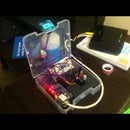Introduction: Computer Overheat Alarm
Purpose:
Overheating of desktop hard drive or a mother board chip set might lead to serious failure.I faced this problem and lost one of my hard drives and valuable personal data. There are lots of softwares available online such as crystalDiskinfo (which I am using) to predict the temperature of your hard disk, but it is always better to set an alert like a sound by a piezo with the help of an alarm. This can be done by setting a limit to the hard disk temperature. This necessity gave me an opportunity to design myself an interactive device that will make a buzz sound when the temperature inside my cabinet exceeds certain limit.
Step 1: Index
Required Materials
Circuit
Sketch/Code
Conclusion
Step 2: Required Materials
Arduino UNO
Solder less Breadboard
16x2 LCD display
8 ohm Speaker
10K ohm Potentiometer
LM35 Temperature Sensor
Jumper Wires
Step 3: Circuit
LCD display:
This will help to monitor the temperature of the desktop hardware. The sketch helps to display Temperature in celcius and Fahrenheit and also voltage recorded near the analog pin/ LM35. This will help to know what exactly is the temperature of the hardware. For my computer, I had set my temperature limit 36deg celcius. You can set the limit as per your requirement.
Attachments
Step 4: Sketch/Code
The following are the LCD pins which are set up in the "Liquid crystal" class.
LCD RS (Register Select) is connected to D12
LCD Enable is connected to D11
LCD DB7 is connected to D2
LCD DB6 is connected to D3
LCD DB5 is connected to D4
LCD DB4 is connected to D5
*/
Attachments
Step 5: Videos/Conclusion:
I designed this device for my own purpose to detect the temperature of the cabinet internal hardware.But this Schematic/code is a generic one and can be used to trigger an alarm where ever overheating is a problem. For example, can detect automobile engine temperature (which I am planning to test on my engine), or room temperature etc.
Note: you can also use other temperature sensors like DS18B20 or NTC-D9 sensors for this but use appropriate calibration relations as per the sensor datasheet.















